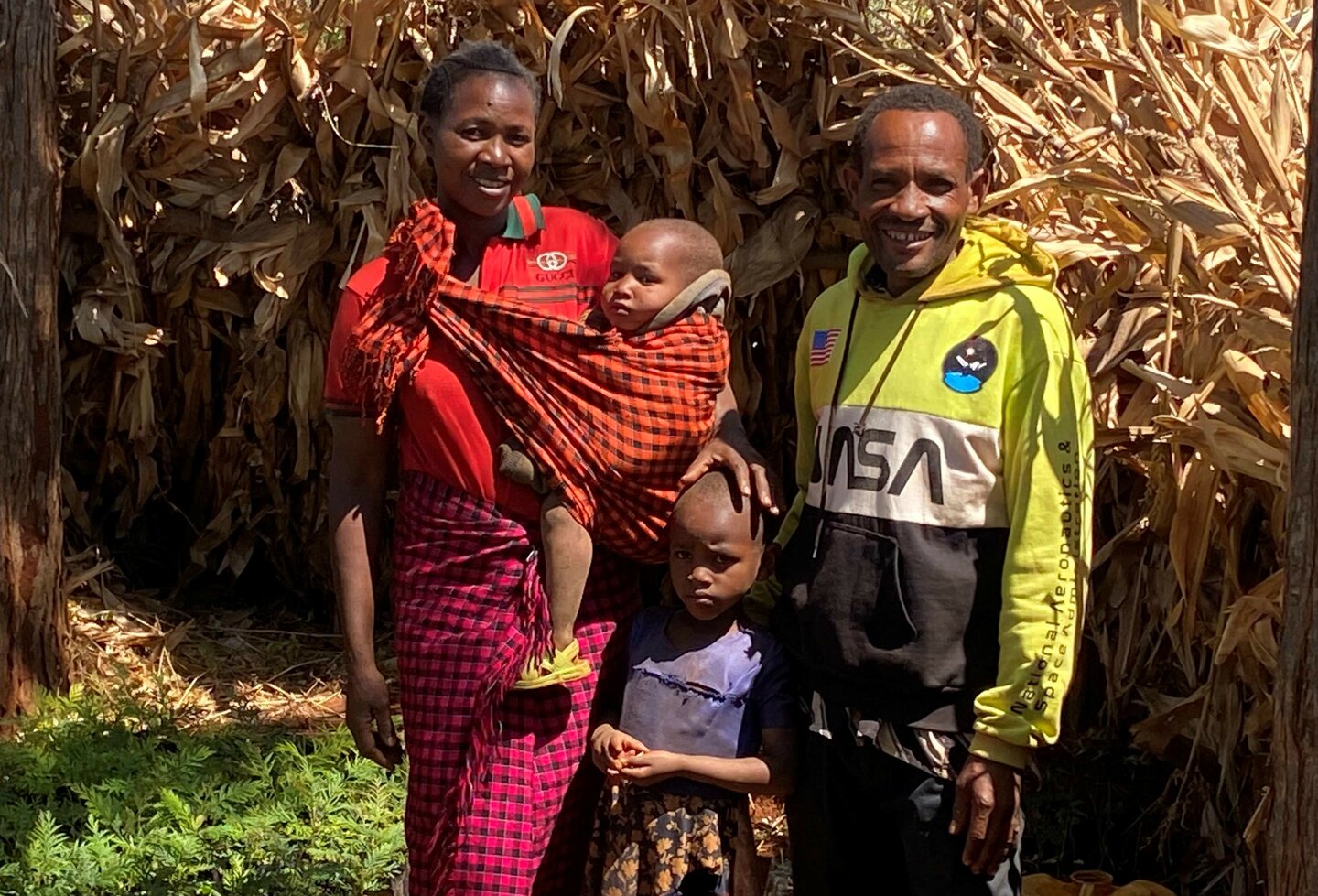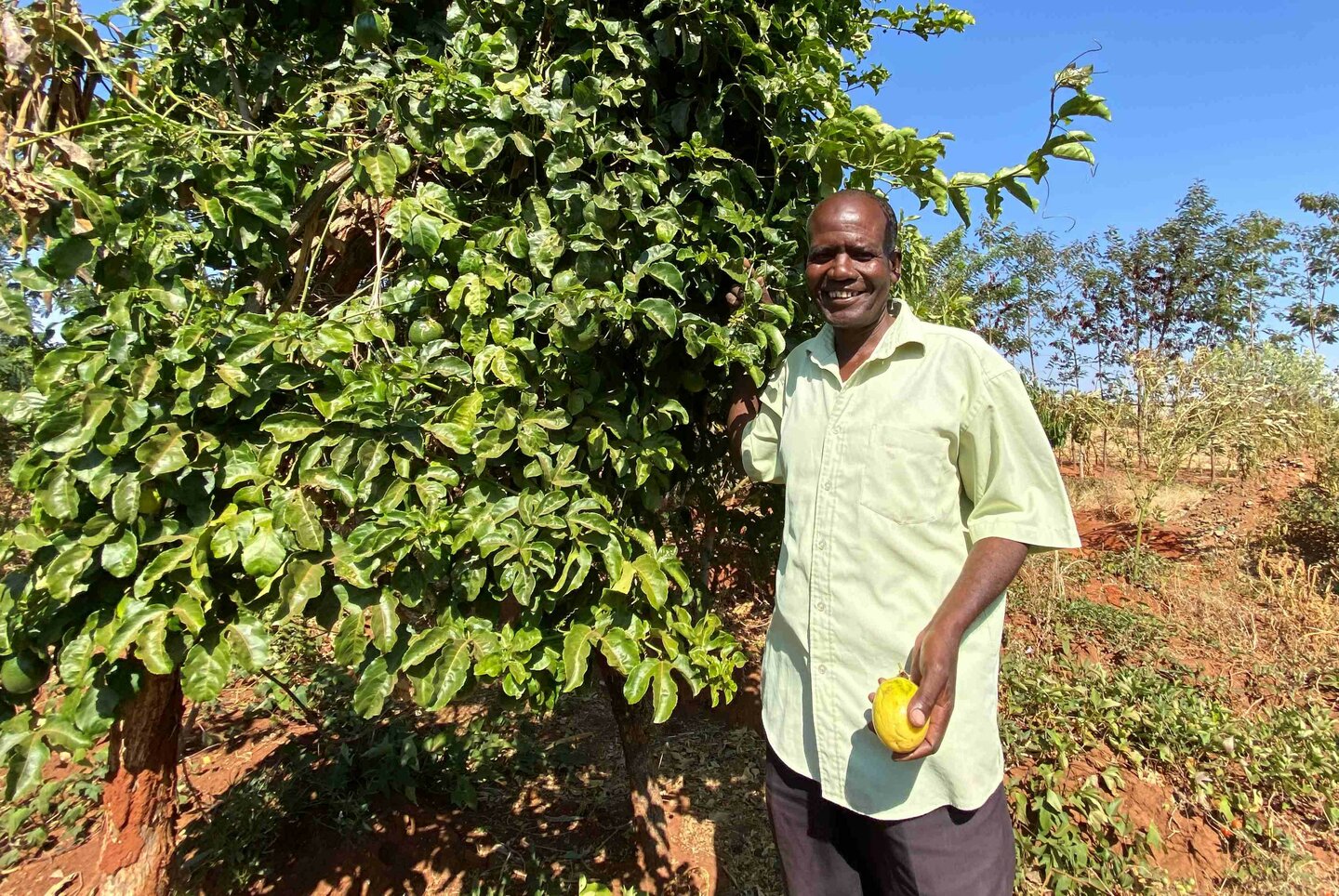A strong wind is blowing, and the sun is just rising over Singida’s saltwater lakes that lie just west of town. When we arrive at the village of Ughandi about 40 minutes later, the wind is still blowing, desiccating what is left of the already harvested cotton and maize fields that we pass. Here on Tanzania’s central plateau, very little grows during the cool dry season. At the invitation of Helvetas’ partner Trees for the Future, we have come to see what a difference tree planting and good soil management could make. Our first stop is the farm of Mohamed Haji Limo.
Greening the farm
Haji, as he likes to be called, has established a forest garden on 1.5 acres of his land – a plot close to his house, bordering a seasonal stream that is currently no more than sand. He is fortunate to have a shallow well that still yields water, although in the past the well has had limited use due to the low fertility of his soil and the communal system of post-harvest open grazing.
The first step in establishing a forest garden is to plant a three-layer hedge. This includes an outer layer of thorny species (Haji planted Acacia polycantha) followed by a row of nitrogen fixing species (Haji planted Gliricidia sepium, although various species of Leucaena and Moringa are also widely used), and then a line of timber trees. Haji has several types of trees, including Grevillea robusta, Acrocarpus fraxinifolius and Cederela odorata. The hedge is crucial as a wind break and for preventing the entrance of marauding livestock; now in its fourth year of growth, it forms a thick barrier. Along the edge of the plot bordering the stream, he planted elephant grass and sugar cane to halt erosion during the rainy season.
Inside the plot, the immediate things that catch the eye are a row of pigeon pea and some stocky papaya trees laden with fruit – but then one starts to notice the numerous lines of other small trees. Avocado, mango, lime, waterberry (Syzigium cuminii), guava, and even some bananas are in the mix, their leaves shredded by the wind. The plot contained three mature local trees when Haji started his garden. He left these, and has tended others that have come up on their own. He has been persuaded, he says, that all trees are good.
Boosting soil fertility
The nitrogen-fixing species in the garden are a crucial part of the design, since they build soil fertility and are used as an organic mulch. Pigeon pea is particularly good in this regard.
In addition, Haji has learned to make compost with all the organic waste from his plot; he blends the waste with ash from the family fireplace and the dung of his nine cows. This has already made a huge difference to soil fertility. Haji says the maize harvested this year was almost three times that of the past. There will always be year-to-year differences in yields, but Haji is clearly convinced of a significant improvement.
Diversifying the household diet
While we talk, Haji’s two youngest daughters, Shadia (7) and Maimuna (3) are quietly carrying water from the well to a vegetable plot. This is Shadia’s pre-school task; little Maimuna is learning from her sister.
Carrots, pumpkin and beetroot are newly sprouting. These are the vegetables that Haji has decided to currently grow; but he points to the remnants of tomatoes, onions, Chinese cabbage, sweet potatoes, okra, chilly, African eggplant, amaranthus, and even hibiscus (for tea). We count an amazing diversity of 34 different species that he has grown at one time or another. Haji’s enthusiasm for crop diversity is no doubt somewhat exceptional – but it is also infectious.
Among most farmers, including those we visit subsequently, a species richness of 10-15 is more common. At the farm of Ally Mahawi and his wife Jacintha in the village of Kijota, Jacintha tells us how much she appreciates the variety in their household diet from the fruit and vegetables that they produce. Their family of nine, she says, are healthier and fall sick less often than in the past. In addition to eating better, they also produce enough sometimes to sell the surplus. The money, she says, contributes towards the schooling of the children.

Replicating the ecosystem’s seven layers
The concept of forest gardens is to utilize seven layers of vegetation. This starts below ground in the form of root crops (such as cassava, carrots, beetroot). Next, at ground level crops such as pumpkins are grown, followed by four layers above – herbs, shrubs, low trees and tall trees. The seventh layer is vines, such as passion fruit. This mimics natural ecosystems and is something well recognized in traditional agroforestry systems, such as the Chaga gardens on the slopes of Mount Kilimanjaro or, further away, the Kandyan spice gardens of Sri Lanka.

But reproducing such diversity on the semi-arid lands of the Singida region is undoubtedly a huge challenge. Water is a continuous problem in the dry season, especially at the beginning, when the trees are just being established. In some cases, Trees for the Future has subsidised the delivery of water to get over this hurdle.
Addressing other challenges
Beyond the obvious challenge of water, Heri Rashid, Trees for the Future’s Country Director in Tanzania, says that false rumors were the biggest problem when they began supporting forest gardens in this locality. Stories circulated that the organization was covertly trying to take over farmers’ land. Despite assurances from village administrators that this was not the case, it took a while to dispel the rumors.
We asked about the engagement of women, since men tend to be the owners of land. Heri assured us that many women are active in creating forest farms, although usually in a husband-wife couple. Another challenge – not confined to this example – is identifying suitable indigenous tree species. Many of those currently used are exotics that are fast-growing and easy to propagate. Finding alternative local species is an on-going task.
Helvetas is already partnering with Trees for the Future on forest gardens in another project, but those in Ughandi and Kijoto are older, and the farmers more experienced. Challenges were especially important to learn about on our visit since we are now starting a new project, Ukijani (“Greening” in Kiswahili). This will specifically focus on engaging women in productive, sustainable environmental management – with forest gardens, including securing women’s land tenure, being one important approach.
About the Authors
Jane Carter is Helvetas’ Senior Advisor for Resource Governance, and Shoma Nangale is the Ukijani Project Manager for Helvetas Tanzania. Kombe Mkunde is the Lead Technician for Trees for the Future Tanzania, and Ally Jumanne Juma is the Assistant Technician at Trees for the Future Tanzania.




